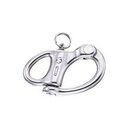My dive flag is connected to a dive reel that has about three hundred feet of string, my theory is that if a boater snags it then I have a few seconds to release my grip on it.
I do have a strobe on it for night dives and that makes me feel a little better, even if it doesn't have any direct affect on the boaters IQ.
I did have my buoy snagged on a night dive once and it scared the chum out of me, but it ended up being some guy fishing from a near by pier at LBTS.
FB-Florida Scuba Diver
I do have a strobe on it for night dives and that makes me feel a little better, even if it doesn't have any direct affect on the boaters IQ.
I did have my buoy snagged on a night dive once and it scared the chum out of me, but it ended up being some guy fishing from a near by pier at LBTS.
FB-Florida Scuba Diver
Last edited:





